- Clone
- 24D2 (See other available formats)
- Regulatory Status
- RUO
- Other Names
- HER2/erbB2, tyrosine kinase cell surface receptor HER2, oncogene ERBB2, oncogene NGL, neuroblastoma- or glioblastoma-derived, HER-2
- Isotype
- Mouse IgG1, κ
- Ave. Rating
- Submit a Review
- Product Citations
- publications
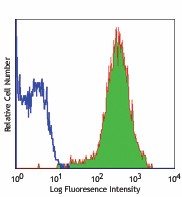
-

Human breast cancer cell line (MCF-7) stained with 24D2 Alexa Fluor® 647 -

BT474 breast cancer cell line was stained with 2 µg/mL anti-human CD340/Her-2 Alexa Fluor® 647 and nuclear counterstained with DAPI. Images were acquired with a TE300 fluorescence microscope with a 20x objective. Data provided by: Er Liu and John Nolan, La Jolla Bioengineering Institute
| Cat # | Size | Price | Quantity Check Availability | Save | ||
|---|---|---|---|---|---|---|
| 324412 | 100 tests | 235€ | ||||
CD340 is also known as HER2/erbB2, tyrosine kinase cell surface receptor HER2, oncogene ERBB2, and oncogene NGL, neuroblastoma- or glioblastoma-derived. It is a member of the epidermal growth factor receptor family of cell membrane tyrosine kinases containing a single transmembrane domain and has an approximate molecular weight of 185 kD. CD340 contains three furin repeats and two cheY homologous receiver domains in the extracellular region (ECR). The HER2/erbB2 protein is expressed on many tumor cells, including some breast cancers, lung adenocarcinoma, gastric cancer, ovarian cancer, gliblastoma, some c-ALL blasts and bone marrow mesenchymal stem cells. Although the erbB2/HER2 protein contains no ligand binding domain, this protein interacts with other EGF receptor family members to form a heterodimer, stabilize ligand binding, and enhance kinase-mediated downstream signaling. CD340 has been shown to be involved in embryonic development and cancer progression; this protein is amplified in adenocarcinoma of the lung, some breast cancers, glioblastoma, gastric cancer, and ovarian carcinoma, where it functions as an oncogene. Overexpression of erbB2 in breast cancers has been shown to confer Taxol resistance and is a therapeutic target in a number of human cancers. The erbB2/HER-2 protein has been shown to interact with a large number of proteins, including SHC1, EGF receptorm, neuroregulin 1, c-Src, integrin β4, Grb2, Grb7, SOS1, caveolin 1, JAK2, PAK1, FAK, and β-catenin, among others. CD340 is extensively modified by tyrosine phosphorylation on multiple residues (Y1023, Y1139, Y1196, Y1221, Y1222, Y1248).
Product DetailsProduct Details
- Verified Reactivity
- Human
- Antibody Type
- Monoclonal
- Host Species
- Mouse
- Immunogen
- NIH-3T3 transfected with human HER-2
- Formulation
- Phosphate-buffered solution, pH 7.2, containing 0.09% sodium azide and BSA (origin USA)
- Preparation
- The antibody was purified by affinity chromatography and conjugated with Alexa Fluor® 647 under optimal conditions.
- Concentration
- Lot-specific (to obtain lot-specific concentration and expiration, please enter the lot number in our Certificate of Analysis online tool.)
- Storage & Handling
- The antibody solution should be stored undiluted between 2°C and 8°C, and protected from prolonged exposure to light. Do not freeze.
- Application
-
FC - Quality tested
ICC - Verified - Recommended Usage
-
Each lot of this antibody is quality control tested by immunofluorescent staining with flow cytometric analysis. For flow cytometric staining, the suggested use of this reagent is 5 µl per million cells in 100 µl staining volume or 5 µl per 100 µl of whole blood.
* Alexa Fluor® 647 has a maximum emission of 668 nm when it is excited at 633nm / 635nm.
Alexa Fluor® and Pacific Blue™ are trademarks of Life Technologies Corporation.
View full statement regarding label licenses - Excitation Laser
-
Red Laser (633 nm)
-
Application References
(PubMed link indicates BioLegend citation) -
- Bühring HJ, et al. 1995. Blood 86:1916.
- Product Citations
-
- RRID
-
AB_2262300 (BioLegend Cat. No. 324412)
Antigen Details
- Structure
- Member of the epidermal growth factor receptor family of cell membrane tyrosine kinases. Single transmembrane pass protein with an approximate molecular weight of 185 kD. Contains three furin repeats and two cheY homologous receiver domains in the ECR.
- Distribution
-
Expressed on many tumor cells including some breast cancers, lung adenocarcinoma, gastric cancer, ovarian cancer, gliblastoma, some c-ALL blasts and bone marrow MSCs.
- Function
- Contains no ligand binding domain and interacts with other EGF receptor family members to form a heterodimer, stabilize ligand binding, and enhance kinase-mediated downstream signaling. Involved in embryonic development and cancer progression.
- Interaction
- CD340 (HER2/erbB2) interacts with a large number of proteins, including SHC1, EGF receptorm, neuroregulin 1, c-Src, integrin β4, Grb2, Grb7, SOS1, caveolin 1, JAK2, PAK1, FAK, and β-catenin, among others.
- Modification
- Extensively modified by tyrosine phosphoryation on multiple residues (Y1023, Y1139, Y1196, Y1221, Y1222, Y1248).
- Cell Type
- Leukemia
- Biology Area
- Cell Biology, Immunology, Neuroscience, Synaptic Biology
- Molecular Family
- Adhesion Molecules, CD Molecules
- Antigen References
-
1. Akiyama T, et al. 1986. Science 232:1644.
2. Bargmann CI, et al. 1986. Nature 319:226.
3. Pegram MD, et al. 1997. Oncogene 15:537.
4. Slamon DJ, et al. 1989. Science 244:707.
5. Leone F, et al. 2003. J. Leukocyte Biol. 74:593. - Gene ID
- 2064 View all products for this Gene ID
- UniProt
- View information about CD340 on UniProt.org
Related FAQs
Other Formats
View All CD340 Reagents Request Custom Conjugation| Description | Clone | Applications |
|---|---|---|
| Purified anti-human CD340 (erbB2/HER-2) | 24D2 | FC,ICC |
| FITC anti-human CD340 (erbB2/HER-2) | 24D2 | FC |
| PE anti-human CD340 (erbB2/HER-2) | 24D2 | FC |
| APC anti-human CD340 (erbB2/HER-2) | 24D2 | FC |
| Alexa Fluor® 488 anti-human CD340 (erbB2/HER-2) | 24D2 | FC |
| Alexa Fluor® 647 anti-human CD340 (erbB2/HER-2) | 24D2 | FC,ICC |
| PE/Cyanine7 anti-human CD340 (erbB2/HER-2) | 24D2 | FC |
| PerCP/Cyanine5.5 anti-human CD340 (erbB2/HER-2) | 24D2 | FC |
| Brilliant Violet 421™ anti-human CD340 (erbB2/HER-2) | 24D2 | FC |
| APC/Fire™ 750 anti-human CD340 (erbB2/HER-2) | 24D2 | FC |
| TotalSeq™-A0133 anti-human CD340 (erbB2/HER-2) | 24D2 | PG |
| TotalSeq™-B0133 anti-human CD340 (erbB2/HER-2) | 24D2 | PG |
| TotalSeq™-C0133 anti-human CD340 (erbB2/HER-2) Antibody | 24D2 | PG |
| PE/Dazzle™ 594 anti-human CD340 (erbB2/HER-2) Antibody | 24D2 | FC |
Customers Also Purchased
Compare Data Across All Formats
This data display is provided for general comparisons between formats.
Your actual data may vary due to variations in samples, target cells, instruments and their settings, staining conditions, and other factors.
If you need assistance with selecting the best format contact our expert technical support team.
-
Purified anti-human CD340 (erbB2/HER-2)

Human breast cancer cell line (MCF-7) stained with purified ... 
BT474 breast cancer cells were stained with anti-CD340 (clon... -
FITC anti-human CD340 (erbB2/HER-2)
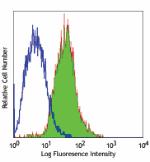
Human breast cancer cell line (MCF-7) stained with 24D2 FITC -
PE anti-human CD340 (erbB2/HER-2)
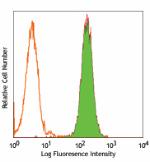
Human breast adenocarcinoma cell line MCF-7 stained with 24D... -
APC anti-human CD340 (erbB2/HER-2)
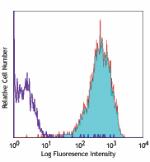
Human breast cancer cell line (MCF-7) stained with 24D2 APC -
Alexa Fluor® 488 anti-human CD340 (erbB2/HER-2)
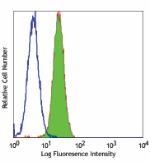
Human breast adenocarcinoma cell line MCF-7 stained with 24D... -
Alexa Fluor® 647 anti-human CD340 (erbB2/HER-2)
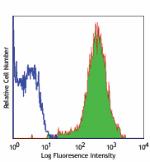
Human breast cancer cell line (MCF-7) stained with 24D2 Alex... 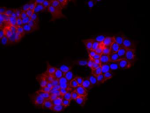
BT474 breast cancer cell line was stained with 2 µg/mL anti-... -
PE/Cyanine7 anti-human CD340 (erbB2/HER-2)
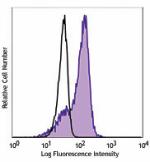
Human breast cancer cell line (MCF-7) was stained with CD340... -
PerCP/Cyanine5.5 anti-human CD340 (erbB2/HER-2)

Human breast cancer cell line (MCF-7) was stained with CD340... -
Brilliant Violet 421™ anti-human CD340 (erbB2/HER-2)
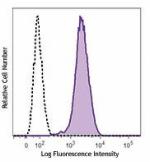
Human breast cancer cell line (MCF-7) was stained with CD340... -
APC/Fire™ 750 anti-human CD340 (erbB2/HER-2)
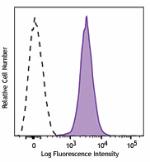
Human breast cancer cell line (MCF-7) was stained with CD340... -
TotalSeq™-A0133 anti-human CD340 (erbB2/HER-2)
-
TotalSeq™-B0133 anti-human CD340 (erbB2/HER-2)
-
TotalSeq™-C0133 anti-human CD340 (erbB2/HER-2) Antibody
-
PE/Dazzle™ 594 anti-human CD340 (erbB2/HER-2) Antibody
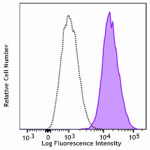
Human breast cancer cell line (MCF-7) was stained with anti-...
 Login / Register
Login / Register 











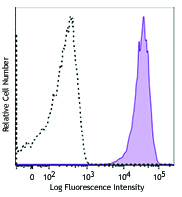

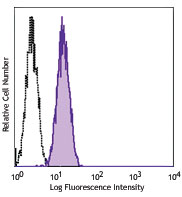



Follow Us